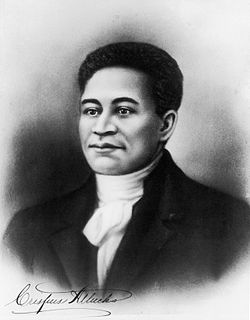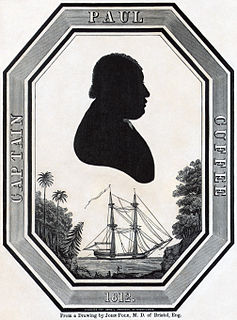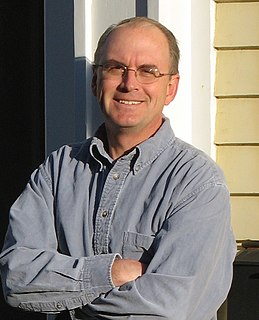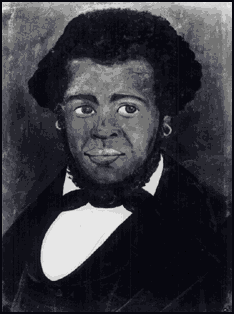
Nantucket is an island about 30 miles (50 km) by ferry south from Cape Cod, in the U.S. state of Massachusetts. Together with the small islands of Tuckernuck and Muskeget, it constitutes the Town of Nantucket, and the conterminous Nantucket County. As of the 2010 census, the population was 10,172. Part of the town is designated the Nantucket CDP, or census-designated place. The region of Surfside on Nantucket is the southernmost settlement in Massachusetts.

Crispus Attucks was an American stevedore of African and Native American descent, widely regarded as the first person killed in the Boston Massacre and thus the first American killed in the American Revolution. Historians disagree on whether he was a free man or an escaped slave, but most agree that he was of Natick and African descent. Two major sources of eyewitness testimony about the Boston Massacre published in 1770 did not refer to him as "black" nor as a "Negro"; it appears that Bostonians viewed him as being of mixed ethnicity. According to a contemporaneous account in the Pennsylvania Gazette, he was a "Mulattoe man, named Crispus Attucks, who was born in Framingham, but lately belonged to New-Providence, and was here in order to go for North Carolina."

Thomas Gibson Nickerson was an American sailor and author. In 1819, when he was fourteen years old, Nickerson served as cabin boy on the whaleship Essex. On this voyage, the ship was sunk by a whale it was pursuing, and the crew spent three months at sea before the survivors were rescued. In 1876 he wrote The Loss of the Ship "Essex," an account of the ordeal and of his subsequent experiences at sea. The manuscript was lost until 1960, and was first published in 1984.

Prince Hall was an abolitionist and leader in the free black community in Boston. He founded Prince Hall Freemasonry and lobbied for education rights for African American children. He was also active in the back-to-Africa movement.

Essex was an American whaler from Nantucket, Massachusetts, which was launched in 1799. In 1820, while at sea in the southern Pacific Ocean under the command of Captain George Pollard Jr., she was attacked and sunk by a sperm whale. Stranded thousands of miles from the coast of South America with little food and water, the 20-man crew was forced to make for land in the ship's surviving whaleboats.
The Stone Fleet consisted of a fleet of aging ships purchased in New Bedford and other New England ports, loaded with stone, and sailed south during the American Civil War by the Union Navy for use as blockships. They were to be deliberately sunk at the entrance of Charleston Harbor, South Carolina in the hope of obstructing blockade runners, then supplying Confederate interests. Although some sank along the way and others were sunk near Tybee Island, Georgia, to serve as breakwaters, wharves for the landing of Union troops, the majority were divided into two lesser fleets. One fleet was sunk to block the south channel off Morris Island, and the other to block the north channel near Rattlesnake Shoals off the present day Isle of Palms in what proved to be failed efforts to block access the main shipping channels into Charleston Harbor.

The Boston African American National Historic Site, in the heart of Boston, Massachusetts's Beacon Hill neighborhood, interprets 15 pre-Civil War structures relating to the history of Boston's 19th-century African-American community. These include the 1806 African Meeting House, the oldest standing black church in the United States.

For the Episcopalian Reverend missionary, see Paul Cuffee (1754-1812).

Nathaniel Philbrick is an American author of history, winner of the National Book Award, and finalist for the Pulitzer Prize. His maritime history, In the Heart of the Sea: The Tragedy of the Whaleship Essex, which tells the true story that inspired Melville's Moby-Dick, won the 2000 National Book Award for Nonfiction and was adapted as a film in 2015.
George Washington Wright was a Californian politician. He was the leading vote getter in a November 1849 at-large election for California's two seats in the United States House of Representatives following California's admission to the Union. He served a partial term in the 31st United States Congress (1850-1851).
Leonard Black was born a slave in Anne Arundel County, Maryland, and was separated from his family by the age of six. He escaped after 20 years of slavery. In 1847 he wrote The Life and Sufferings of Leonard Black: A Fugitive from Slavery. With encouragement and support, he became a Baptist minister, preaching in Boston, Providence, and Nantucket before becoming minister of First Baptist Church in Petersburg, Virginia.

William B. Gould was a former slave and veteran of the American Civil War.
Thomas Dalton (1794–1883) was a free African American raised in Massachusetts who was dedicated to improving the lives of people of color. He was active, at times with his wife Lucy Lew Dalton, in the founding or ongoing activities of local educational organizations, including the Massachusetts General Colored Association, New England Anti-Slavery Society, Boston Mutual Lyceum, and Infant School Association, and campaigned for school integration, which was achieved in 1855.

The Bucks of America was a Patriot Massachusetts Militia company, during the American Revolutionary War, that was composed of African-American soldiers. Few records survive about the unit; most of its history is constructed from eyewitness accounts. No official military records pertaining to the Bucks of America exist or have survived.

Robert Morris was one of the first African-American attorneys in the United States, and was called "the first really successful colored lawyer in America."

Absalom Boston (1785–1855) was a United States mariner who was the first African-American captain to sail a whaleship, with an all-black crew, in 1822.

John Telemachus Hilton was an African-American abolitionist who established barber, furniture dealer and employment agency businesses. He was a Prince Hall Mason and established the Prince Hall National Grand Lodge of North America and served as its first National Grand Master for ten years. He also was a founding member of the Massachusetts General Colored Association, and active member and author in the Anti-Slavery movement.
George Pollard Jr. (1791–1870) was the captain of the whalers Essex and Two Brothers, both of which sank. Pollard's life, including his encounter with the sperm whale that sank Essex, served as inspiration for Captain Ahab, the whale-obsessed character in Herman Melville's Moby-Dick.

Austin Bearse (1808-1881) was a sea captain from Cape Cod who provided transportation for fugitive slaves in the years leading up to the American Civil War.
Mary Coffin Starbuck was a Quaker leader from the Massachusetts Bay Colony. She and her husband, Nathaniel Starbuck, were the first couple to marry on Nantucket and were parents to the first child born on the island. She supported her husband's efforts to run a trading post, which grew into a large mercantile business with the advent of the whaling trade. Unusual for the time, she was a prominent leader in civic and religious matters. She had ten children and her family members were leaders in the Quaker meeting.













